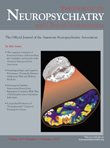Secondary Mania After Pontin Cavernous Angioma
SIR: Secondary mania has been reported with toxic and metabolic disturbances, primary and metastatic brain tumors, epilepsy, and cerebrovascular events. We present a patient who developed a manic episode after a pontin cavernous angioma. To our knowledge, this is the first report describing secondary mania in a case with vascular angioma in the pons.
Case Report
A 34-year-old man was admitted to our department with the chief complaint of significant personality changes. His family reported enhanced talkativeness, increased psychomotor activities, increased sex drive, and decreased need for sleep for 1 week. He was unable to perform his job and his social activities were impaired. During a mental status examination, he was alert but his distractibility was outstanding and he did not establish eye contact. There were no perceptional abnormalities. The patient had rapid, increased talking and laughing and had grandiose ideas. He was overly excited and euphoric. Abstract thinking, judgment abilities, and insight were not impaired. His mood was anxious and he became irritable when hindered. The patient frequently acted in an impulsive way. He had no premorbid psychiatric and medical history, family history of affective disorder, or alcohol or substance addiction. His neurological examination was intact.
One day after his admittance, the patient was examined with a structured psychiatric interview and scales for measurement of impairment in activities of daily living, intellectual function, and social functioning. His Young Mania Rating Scale (YMRS) score was 46. Routine laboratory tests including thyroid hormones and thyroid-stimulating hormones were within normal limits. T2-weighted magnetic resonance images showed a well-circumscribed, lobulated lesion with a heterogenous core due to varying stages of blood products and surrounded by a rim in pons. These findings indicated cavernous angioma. Digital subtraction angiography was considered normal.
We administred a regimen of carbamezapin, 400 mg/d, but the symptoms continued. Two weeks later, he developed jerk nystagmus in primary position, vertical and lateral gaze, postural tremor, truncal ataxia, and left hemiparesis while his manic symptoms lasted. Two months later, a midline suboccipital craniectomy was performed and the lesion was dissected. Following surgery, psychomotor activation decreased, speech slowed down and sleep was regulated. We discontinued drugs. One month later the level of YMRS decreased to 20 points. His manic symptoms improved but nystagmus and slight left hemiparesis persisted.
Comment
10% to 30% of intracranial cavernomas are located in the posterior cranial fossa. 1 Characteristic symptoms of brainstem cavernous malformations include headache, emesis, ataxia, nystagmus, diplopia, hemiparesis, sensory changes, and change in mental status. 2 Several studies demonstrated a significant association between secondary mania and lesions involving cortical and subcortical regions of the right hemisphere. In mania, there is an increase in dopamine, serotonin, and noradrenaline transmission from the substantia nigra, raphe nuclei, and locus coeruleus to all areas of the brain, compared with a nondiseased brain. It seems that the main brain areas involved in mania include the frontal and temporal lobes of the forebrain, the prefrontal cortex, the basal ganglia, and parts of the limbic system. However, a dysfunction in any brain region associated with these mood-regulating circuits may lead to the development of a mood disorder. 3 , 4 Drake et al. reported two cases of people who developed mania after ventral pontine infarction and suggested that brainstem disturbances can influence mood, sleep, libido, and thought. 5 In reviewing the literature, we did not find that mania occurs because of any vascular malformation in the pons. It is possible that abnormalities in these circuits confer a biological vulnerability, which, when combined with environmental factors, causes mood disorders.
1 . Wilms G, Bleus E, Demaerel P: Simultaneous occurrence of developmental venous anomalies and cavernous angiomas. AJNR Am J Neuroradiol 1994; 15:1247–1254Google Scholar
2 . Barrow D, Krisht A: Cavernous malformations and hemorrhage. In Awad I, Barrow D, Eds. Cavernous malformations. Park Ridge AANS 1993:65–80Google Scholar
3 . Manji HK, Lenox RH: The nature of bipolar disorder. J Clin Psychiatry 2000; 61:42–57Google Scholar
4 . Soares JC, Mann JJ: The anatomy of mood disorders-review of structural neuroanatomy. Biol Psychiatry 1997; 41:86–106Google Scholar
5 . Drake ME Jr, Pakalnis A, Phillips B: Secondary mania after ventral pontine infarction. J Neuropsychiatry Clin Neurosci 1990; 2:322–325Google Scholar



